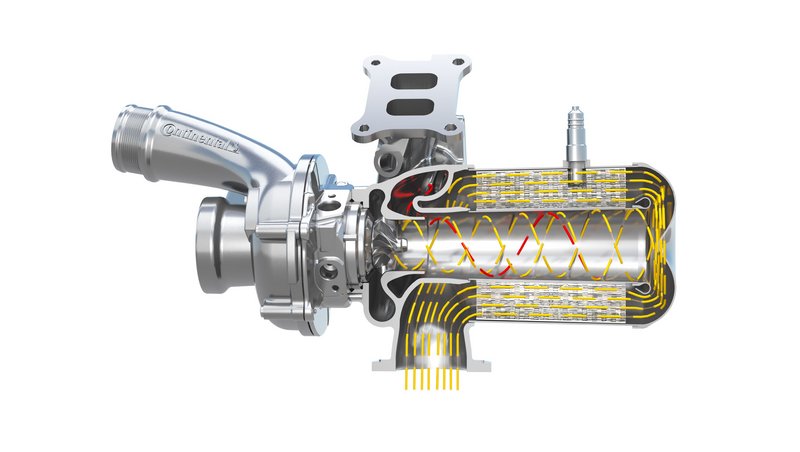Innovations for a Clean Mobility Mix
- In the world of powertrain systems, variety is the watchword: Continental supports unlimited clean mobility for every car driver and every individual user profile
- World’s first ring catalyst turbocharger further boosts engine efficiency in hybrids
- In harness with EMICAT electrical heating technology the ring catalyst turbocharger realizes emission robustness while simultaneously reducing the carbon footprint
- Innovations range from clean combustion engines via new 48-volt high-power electrification with 30 kW peak output all the way to fuel cells
Regensburg, Vienna May 15, 2019. At the 40th Vienna Motor Symposium (May 15-17), Continental will be presenting examples of how to further improve different types of powertrain. In the real world of powertrain systems for passenger cars, variety is the watchword. For example, the requirements of drivers in rural areas are notably different from those of city-dwellers. The fact is that, where alternative drive systems are concerned, everything depends of the intended application. And here it is market forces that are decisive and not political decision-makers alone.
Super-clean diesel and gasoline engine combined with electric drive already help the climate today. Along with the drop in emissions that the electric motor brings, intelligent innovations also further enhance the efficiency of the combustion engine. In addition, at the Vienna Motor Symposium, Continental Powertrain is unveiling the ring catalyst turbocharger. This highly integrated combination of turbocharger and catalyst is a new arrival on the scene which offers additional benefits compared to separately installing the individual components. However, the ring catalyst turbocharger is only one element in a Continental technology portfolio that includes solutions for all powertrain configurations: software, hardware, control units, exhaust gas aftertreatment, use of synthetic fuels, and electrification.
“Drivers choose the mobility they need to match how and where they live. We are currently in the midst of a transformation in the drive systems sector and in the interests of unlimited clean mobility we support all the different drive systems,” said Andreas Wolf, head of Continental Powertrain. “It’s our job to cover all levels and to pull out all the stops to make mobility cleaner. This is why we’re pushing ahead with technologies for the whole powertrain mix.”
The world´s first ring catalyst turbocharger – offering fuel savings plus emission robustness
The ring catalyst turbocharger presented for the first time in Vienna is a further development of the RAAX® turbocharger and Continental’s ring catalyst technology. After passing through the turbine, the exhaust gas flows into a conical mixing pipe enabling an almost ideal pressure recovery. At the end of this pipe, the exhaust mass flow is redirected and passed through the ring-shaped 3-way catalyst which surrounds the mixing pipe.
In conventional turbochargers, the exhaust gases quickly expand as they leave the turbine, which causes fluid dynamic losses and impacts efficiency. This is solved by the ring catalyst turbocharger, where the conical mixing pipe permits controlled expansion, leading to reduced back pressure. In addition, the exhaust gas from the wastegate is fed through an annular gap around the mixing pipe, facilitating low-loss mixing with the exhaust gas flow leaving the turbine impeller. As a result, the exhaust gas temperature distribution is homogeneous when it reaches the catalyst. This has a positive impact on both the efficiency and the service life of the catalyst. It also means that λ=1 operation can be extended. Consequently, this ring catalyst turbocharger is notably economical in operation. “If we combine it in hybrid vehicles with EMICAT® electrical heating technology, then we’re rolling together fuel saving and minimized emissions even during cold starts and after prolonged engine-off phases,” said Rolf Brück, head of Catalysts and Filters at the Powertrain Components business unit.
The electric power for heating the catalyst can be provided by an efficient 48-volt hybrid solution. With the Super Clean Electrified Diesel research vehicle, Continental demonstrated on a dynamometer that the electrically heatable catalyst makes it possible to comply even with the demanding London Traffic Cycle. NOx output during this short cycle with many idle times (jams), low engine load and repeated moving off from standstill was below 27 mg/km. At the same time, CO2 output dropped by 4 g/km. “The intelligent use of electrification in harness with a combustion engine has earned its place as a form of unlimited clean mobility,” added Brück.
48-volt 30 kW high-power electrification – more electricity for energy-saving driving
Also on show in Vienna is the electric motor newly developed by Continental to implement 48-volt high-power electrification. This electric motor delivers peak output of up to 30 kW, thus offering not only more torque to support the combustion engine electrically and enable quiet, purely electric inner-city journeys, but also a recuperation performance that is higher by a factor of almost 2 − and therefore more electricity for energy-saving and emission-reducing modes of operation. The entire unit comprising electric motor and integrated inverter is extremely compact and delivers an efficiency of well over 90%.
“We anticipate many 48-volt applications in the near future and are confident that this 48-volt high-power electrification will enable us to use more CO2-saving functions in hybrids that currently require far more elaborate and cost-intensive high-voltage hybridization,” said Stefan Rebhan, head of Powertrain Technology & Innovation. “In the long term we anticipate a powertrain mix of hybrid drives, all-electric drives and fuel-cell drives – and in all of these solutions there are great opportunities to help protect the climate.”

Simone Geldhäuser
Head of Media Relations & Press Spokesperson Innovation & Technology
Vitesco Technologies
- +49 941 790-9961302


